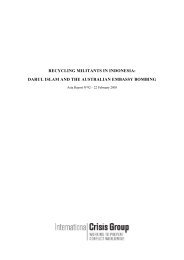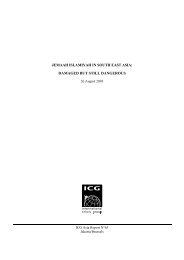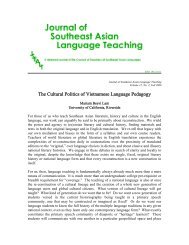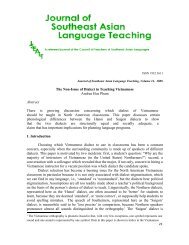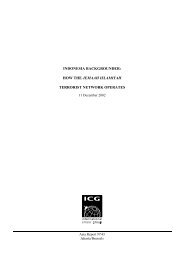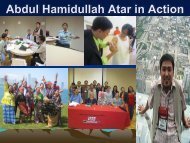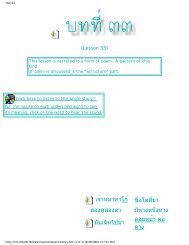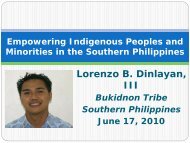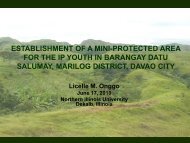Introduction - SEAsite - Northern Illinois University
Introduction - SEAsite - Northern Illinois University
Introduction - SEAsite - Northern Illinois University
You also want an ePaper? Increase the reach of your titles
YUMPU automatically turns print PDFs into web optimized ePapers that Google loves.
Prentation Abstracts<br />
their infancy. In schools and society as a whole, the arts, music, literature and<br />
humanities curricula had not been well developed. Even today, the Lao people at<br />
home and abroad continue to emphasize their history in ceremonies, rituals, music,<br />
dance, cuisine and the other forms of culture rather than researching and documenting<br />
these aspects of the Laotian cultural heritage. This practice has created<br />
frustration in the new generations of Laotians who want to understand the history<br />
of their ancestors.<br />
Beyond the references, parts of the information contained in this paper have<br />
been selected from my previous research projects. Over one hundred Lao-American<br />
community members across the country were interviewed. Since then, many<br />
of them are now deceased and only their voices and photographs are left behind.<br />
The memories of my childhood experiences in the Kingdom of Laos, as a foreign<br />
student in the United States who witnessed the anti-Indochina War efforts, as a<br />
refugee resettlement officer, as a Lao cultural presenter, as an artist and a Lao<br />
Cultural Consultant to the Smithsonian Institution, and other academic institutions<br />
also provide substantial information.<br />
Thongkhoun T. Pathana<br />
Transformation of the Buddhist language into Lao-Modern<br />
architecture. What is Laotian Modern Architecture?<br />
President, Laotian Community Center of RI, Inc., Rhode Island<br />
I salute every Chetiya (shrine) that may stand in any place the bodily relics,<br />
the Great Bodhi and all images of the Buddha.” ( Ven. Dhammananda 67)<br />
The focus of this research and studies is to investigate, “Laotian Buddhist<br />
practice in terms of the Buddhist religious iconography and architectural form”.<br />
The iconographic expression is represented in its themes, languages, metaphors,<br />
and spiritual forms as seen through speculation and interpretation.<br />
Although the language of Buddhist’s Buddhology does not change, the collaboration<br />
of its society and cultures are always impermanent in both time and<br />
place. Symbols and themes, in terms of architecture, are not redefined but interpreted<br />
and adapted within the Buddhist religious expression. Its re-representation<br />
and reinterpretation is expected to be found in the contemporary Buddhist<br />
temple.<br />
The selection of site must reflect some specific elements of the Buddhist religion<br />
in terms of culture, ritual, ceremony, festival, tradition, physical orientation, and<br />
the sacred building where the faith is practiced. The Buddhist cosmology of the<br />
site and the Buddhist monasteries are designed to face a body of water towards<br />
the east (a representation of awakening). The integration of water themes play a<br />
major role in cosmological imagery.* These elements form their own language<br />
through iconographic representation of imagery in Buddhist religious monastery<br />
and through its function within the ritual activities in the temple. The issue of the<br />
site selection is unlike the traditional or Laotian’s mythology. The Buddhist Temple<br />
in American cities has been formed upon its own culture and history, removed<br />
from Laotian Buddhist religion. The so-called “congregation and contemplation”<br />
is related to both the American city and its’ way of life. These investigations will<br />
allow me to determine the most suitable site for the focal point of the Laotian<br />
Buddhist Temple Center.<br />
The program has been divided into three categories, reflecting three realms or<br />
aspects of Buddhist religious iconography and the Ultimate Goal of Buddha Dharma<br />
(the three worlds). The three primary Buddhist structures are: first, the various<br />
facilities needed to sustain the life of the monastery (Kuti or viharas); second, the<br />
stupa or pagoda (the Great Bodhi Tree); third, the imagery of Buddha, known as<br />
the lotus. These elements concerned with the contemporary issues can be explored<br />
through the public, private, suburban, ritualistic levels of the sanctuary and shrine.<br />
Whatever the form of the structure, the Buddhist worship involves circumambulation,<br />
a custom easily followed in the context of a freestanding stupa.<br />
The vehicle of the Lao architecture studies is to search for the meanings in<br />
one ‘s culture and in particular, one’s religious needs and the historic background<br />
in terms of the symbols, images and metaphors that it represents. In regards to the<br />
cave, sculptures, arts and other Laotian Buddhist elements, they begin to generate<br />
the formal strategy in the practice. This allows the architectural interpretation to<br />
integrate both organization and programmatic elements within the condition of<br />
the city and becoming an ideal within a contemporary society. Can a speculation<br />
of ‘shrine or chatiya’ be used theoretically? It represents both icon of the temple<br />
and the image of Buddha, what defines the complex relationship between icon and<br />
building? This leads to the investigation of the city’s history, demographic and<br />
culture identity.<br />
Fongsamuth Phengphaengsy*<br />
Sustainable Irrigation Project in Lao PDR: Effective<br />
Management of Pump Irrigation Projects in Mekong<br />
River and its Tributaries<br />
Department of International Environmental Agriculture and Science, Tokyo <strong>University</strong><br />
of Agriculture and Technology, Japan<br />
Lecturer of irrigation, Department of Water Resource Engineering<br />
National <strong>University</strong> of Lao PDR<br />
Irrigation is the major agricultural technique applied for paddy cultivation<br />
due to there is no rainfall in dry season. Therefore, government invested a lot of<br />
money in developing the irrigation sector in order to increase rice production and<br />
stable self-sufficiency. In particular, expanding the dry-season irrigated agriculture<br />
areas have been heavily promoted during 1996-2000. Government initiated a<br />
radical measure to increase rice production by distributing more than 8,000 pump<br />
units along Mekong River and its tributaries in 3 main plains of Vientiane, Savannakhet<br />
and Khammuan Provinces. This project boosted the paddy production<br />
remarkably from 1.4 million tones in 1996 to 2.2 million tones in 2000, and then<br />
government declared rice self-sufficiency in this year.<br />
Despite their apparent attractiveness in terms of potential productivity,<br />
pumping irrigation schemes become to have several problems. Most schemes have<br />
poor performance and operate below capacity due to the lack of lesson on proper<br />
management. After 2000, farmers in pump scheme have refused growing rice in<br />
dry season. As a result, dry-season planted area has been gradually decreasing<br />
from 102,000 ha in 2001 to 84,000 ha in 2002 and 81,000 ha in 2003. This left<br />
from target of 120,000 ha in 2003. Finally, many schemes had largely become<br />
totally disillusioned and abandon. Therefore, pumping project assessment will be<br />
needed to identify the problems and trial for solution in order to improve and<br />
sustain the projects. The study was conducted in 3 pump projects: Kao Leo 2<br />
pumping irrigation project located at Mekong River in Vientiane Municipality,<br />
Pak Khagnoung pump project at Num Ngum River in Vientiane province and Ton<br />
Hen pump project at Se-Bangfai River in Savannakhet province. Farm households<br />
of 40% in each scheme were interviewed concerning their dissatisfactory of using<br />
pump irrigation scheme for dry season cultivation. The study classifies project<br />
problems and particularly evaluates irrigation facilities, water distribution issue,<br />
actual planted areas, water fee collection and Water User Group.<br />
The result showed that decreasing percentage of water fee collection, increasing<br />
electricity charge, weakness of Water User Group and poor condition of<br />
irrigation facilities - canals, pumps and water gates - are the main factors, resulting<br />
to projects become problems. Kao Leo 2 project has serious performance. Only<br />
25% of total project areas were cultivated. Water irrigation fee could be collected<br />
only 25% of total number of farmers. This was due to farmers misunderstanding<br />
of their responsibility to the irrigation system and also irrigation system itself<br />
was incomplete in function properly with poor water distribution. More than 80%<br />
of interview farmers complained water was not enough for their cultivation. The<br />
study concludes that Irrigation water fee is the key component in order to maintain<br />
scheme operating well. Without this fee, irrigation facilities are unable to maintain<br />
and then water supply is poorly distributed. Water User Group also plays an<br />
important key as they suppose to responsible for water distribution and encourage<br />
member to become understand of their responsibilities for irrigation system.<br />
Tutu Phimviengkham<br />
Awakening Ancient Voices of Sang Sin Xai through Radio<br />
Gokhokho Publishing, Inc., Washington, DC<br />
The people of Laos have a strong oral tradition that is quickly disappearing<br />
in the modern era, taking with it the oral rendition of such epic poems like Sang<br />
Sin Xai, Vetsantrasadok (Phravetsandon), Xieng Mieng and others. Ironically, the<br />
explosion of modern media may be attributed to the extinction of oral transmission<br />
of knowledge and stories; however, such media also has the power to recreate,<br />
reinvent and preserve the art of storytelling. This paper will demonstrate how an<br />
ancient epic poem like Sang Sin Xai can be recreated with media production for<br />
the young and old to enjoy.






